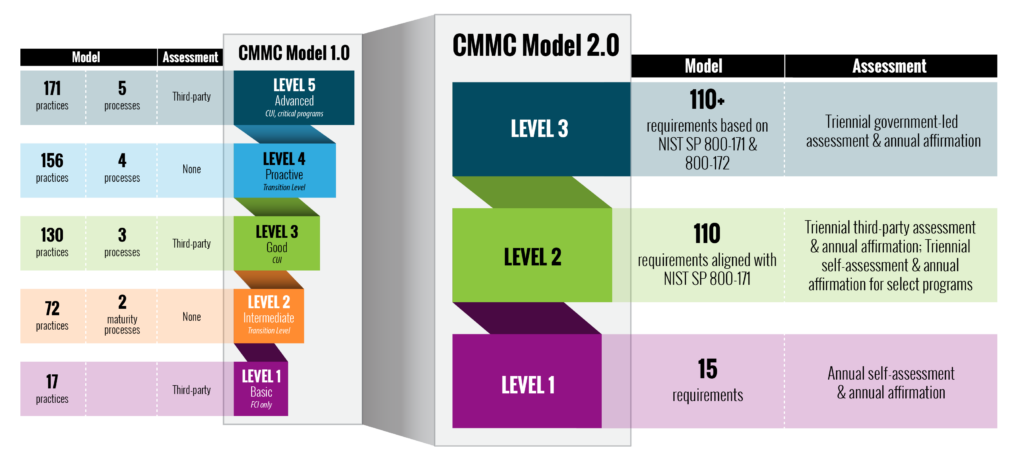When it comes to cybersecurity, the stakes are higher than ever, especially for businesses dealing with the U.S. Department of Defense (DoD). The Cybersecurity Maturity Model Certification (CMMC) has emerged as a critical framework to ensure that contractors and subcontractors are safeguarding sensitive information appropriately and recent updates with CMMC 2.0 are bringing even more clarity and efficiency to the process.
Understanding the Basics of CMMC
The CMMC framework was introduced by the DoD to enhance cybersecurity across the Defense Industrial Base (DIB). It standardizes cybersecurity practices and integrates them into a tiered compliance model, focusing on protecting Federal Contract Information (FCI) and Controlled Unclassified Information (CUI). Originally structured across five levels of maturity, CMMC provides a roadmap to enhance your cybersecurity posture mainly to gain and maintain government contracts, ranging from basic cyber hygiene (Level 1) to advanced and progressive practices (Level 5).
What’s New in CMMC 2.0?
CMMC 2.0, recently finalized, streamlines the original model by reducing the certification levels from five to three:
- Level 1 – Foundational: Focuses on basic cyber hygiene practices, similar to the original Level 1.
- Level 2 – Advanced: This replaces the previous Levels 2 and 3, incorporating more rigorous practices aligned with the National Institute of Standards and Technology (NIST) SP 800-171.
- Level 3 – Expert: Combines the higher-level practices from the previous Levels 4 and 5 and aligns them with NIST SP 800-172.
CMMC 2.0 simplifies the certification process and reduces the burden on small businesses by allowing self-assessment at Level 1 and biannual third-party assessments for Level 2. Level 3 still requires government-led assessments.
Previous CMMC 1.0 Levels
- Level 1 – Basic Cyber Hygiene: Focuses on basic safeguarding requirements, such as using antivirus software and regular password changes. This level is foundational and ensures minimal security controls are in place.
- Level 2 – Intermediate Cyber Hygiene: Implements some additional practices to establish a cybersecurity culture within the organization. It prepares contractors for handling CUI.
- Level 3 – Good Cyber Hygiene: Incorporates the full suite of cybersecurity practices necessary to protect CUI. At this level, an organization must demonstrate the ability to manage and reduce risks.
- Level 4 – Proactive: Emphasizes advanced and proactive practices. This level requires organizations to review and measure practices to address evolving cybersecurity threats.
- Level 5 – Advanced/Progressive: At the pinnacle of CMMC, organizations are expected to optimize their security practices and ensure they are adaptable to the dynamic threat landscape.

The Importance of CMMC Compliance
CMMC is not just another box to tick; it’s an essential requirement for any business wishing to secure DoD contracts. By implementing CMMC, companies are taking significant steps toward protecting sensitive data and maintaining trust with the DoD. Non-compliance can result in the loss of contracts, financial penalties, and long-term damage to your reputation.
The framework also serves as a roadmap for businesses looking to strengthen their overall cybersecurity posture, even beyond the DoD context. By following the CMMC guidelines, your company is better equipped to handle not only government contracts but also to meet the growing cybersecurity expectations across various industries.
How to Approach CMMC Certification
The first step towards CMMC compliance is to perform a gap analysis to identify where your current practices fall short of the required standards. From there, you can develop a tailored action plan to close these gaps. Resources like the Quatronics CMMC Level 1 Implementation Guide provide detailed insights into the steps needed to achieve certification at various levels.
Each level of CMMC builds upon the previous one, making it crucial to establish strong fundamentals before advancing to more complex requirements. Whether it’s implementing multifactor authentication, conducting regular security assessments, or training your staff on cybersecurity best practices, each step you take strengthens your defense against potential threats.
Final Thoughts
CMMC is more than just a certification—it’s a commitment to maintaining high cybersecurity standards. By understanding and implementing CMMC, you’re protecting your business and contributing to the overall security of the nation’s defense supply chain. This also ensures you can secure government contracts within the DiB sector.
For those looking to get started, remember that CMMC is a journey, and it’s okay to take it one step at a time. Utilize the resources available, like the implementation guides from Quatronics, and stay informed about updates and changes in the CMMC framework.